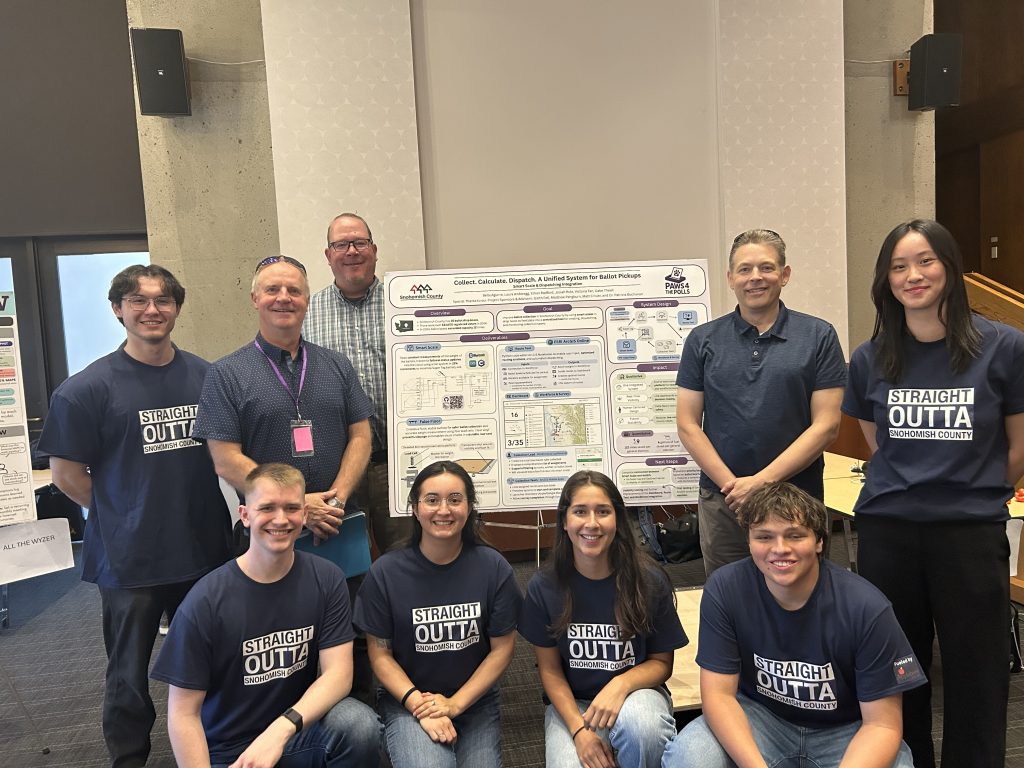EVERETT – A team of University of Washington students from the Industrial and Systems Engineering Department has developed a comprehensive technology solution to help Snohomish County improve its ballot collection process, demonstrating how academic partnerships can drive real-world innovation in election administration.

The six-student capstone team created an integrated system called “Collect. Calculate. Dispatch.” that addresses a challenge facing the county: efficiently managing ballot pickups from 35 drop boxes serving more than 533,000 registered voters. In the November 2024 General Election alone, more than 290,000 voters returned their ballot through a Snohomish County drop box, highlighting the potential impact of better collection coordination.
“This project is a great example of the value of our capstone program – students tackle real challenges that matter to our communities while developing critical problem-solving skills,” said Professor Patricia Buchanan, who leads the Industrial & Systems Engineering capstone program. “This team combined technical innovation with human-centered design principles, creating solutions that work for the people who will actually use them. These hands-on partnerships give our students invaluable experience while delivering meaningful results for our community partners.”
The student-developed solution features three key components: a smart scale system that continuously monitors ballot box weight and transmits fullness data in real-time, a route optimization tool that creates efficient collection paths, and an integrated dashboard that provides live visibility into collection operations. The modular design allows the county to implement the system gradually while maintaining cost-effectiveness.

“I am extremely impressed with the quality of work of our UW capstone team,” said Garth Fell, Snohomish County Auditor. “The students were organized, collaborative, and motivated. They quickly learned how our ballot collection process works and identified key areas where they could add value. Using sound methodology to rank opportunities and evaluate potential enhancements, they developed quality prototypes that are ready for field testing in future elections. Our team is grateful for the chance to work with such talented students.”
The project delivers measurable benefits. The optimized routing system saves 122 miles traveled between boxes per general election and costs $1,000 less than purchasing pre-built scales. Beyond the quantitative improvements, the system enhances staff safety through ergonomic design features and provides election officials with unprecedented visibility into collection operations.
“Our ongoing partnership with the University of Washington College of Engineering supporting the capstone program has once again proven to be very meaningful for the county,” Snohomish County IT Director Viggo Forde said. “The students bring such positive energy and engagement and this contributed to a great project with very meaningful insights to our elections team.”
The capstone team – Bella Aguirre, Laura Anderegg, Ethan Radford, Josiah Rule, Victoria Tan, and Gabe Theall – spent an academic year working directly with county officials to understand existing processes, identify improvement opportunities, and develop solutions. Their approach exemplifies the University of Washington’s commitment to tackling real-world challenges through collaborative innovation.
The system is designed for future scalability and will undergo pilot testing in upcoming elections. Next steps include completing the connection between the smart scale and dashboard systems, implementing priority-based routing based on ballot box fullness, and conducting usability testing to refine the user experience.
This project represents the latest success in Snohomish County’s partnership with the UW College of Engineering’s Industry Capstone Program, which connects student teams with organizations to solve complex, real-world problems. The program demonstrates how academic institutions and government agencies can work together to drive innovation while preparing the next generation of engineers to make a positive impact.
Source: Snohomish County Auditor’s Office
Author: Lynnwood Times Staff









